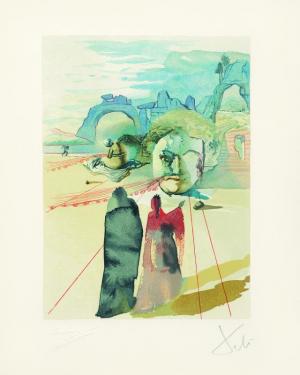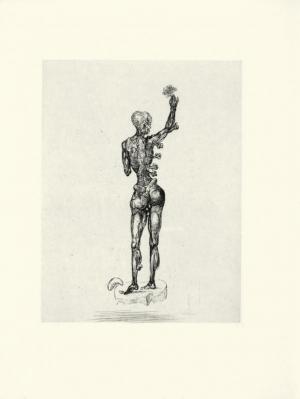Salvador Dalí illustrations exhibit at Biggs to start Dec. 4
Beginning Friday, Dec. 4, the Biggs Museum of American Art welcomes a traveling exhibition of Salvador Dalí's Illustrations for Les Chants de Maldoror and The Divine Comedy, titled Stairway to Heaven: Life and Death in the Visions of Salvador Dalí. All the works are from the collection of Park West Museum in Southfield, Mich. This exhibition is organized by the Carole Sorell Inc. with generous support from the Park West Foundation. After delighting audiences nationwide, the exhibition's almost three-year U.S. tour will end Feb. 8 at the Biggs.
Salvador Dalí (1904-89) is among the most recognized and eccentric artists of the 20th century. He layered the surreal imagery of his “paranoiac-critical method” onto hundreds of artworks, including paintings, theatrical designs, films, architecture, sculptures, jewelry and fine art prints, such as those featured in Life and Death in the Visions of Salvador Dalí. Created for two publications, the artworks in this exhibition signal two distinct periods in Dalí’s career: the hedonism of his youth and the redemption he sought later in life. These two sets of artworks also signal his transition from Surrealism to Mysticism, which can be seen in this exhibition through his unwavering technical mastery in printmaking and draftsmanship. With nearly 150 individual artworks on view, this exhibition provides an expansive selection to interpret Dalí‘s dream-like subjects.
Dalí was born and academically trained in Spain. Instead of finishing his education, the burgeoning artist went to Paris where he was surrounded by modern painters such as Pablo Picasso, René Magritte and Joan Miró. However, his romantic painting style and fine draftsmanship, as well as his unusual tactics of attracting attention, gained him a home with the growing Surrealist movement of the 1920s. His technical skill and his audacious self-promotion cemented his popularity. This early and shocking imagery was later replaced with ethereal and religious subjects that further endeared an ever-widening patron base to his mystical subjects.
Under the influence of intimate friends and poets such as Federico García Lorca and André Breton, Dalí became equally infatuated with the sadistic and amoral subjects of the Surrealist icon, the Count of Lutréamont (pseudonym of the French Uruguayan romantic poet Isidore Lucien Ducasse). Dalí was soon asked to supply illustrations for a reprinting of the Count of Lutréamont’s epic poem, Les Chants de Maldoror (1868-9). The artist created 44 original intaglio prints for the publication. Less illustrations of the Maldoror narrative, Dalí’s prints are more like the early paintings that he was creating at this time – a personal reflection into his own mental health and dramatic lifestyle. This was among his earliest book projects; however, Dalí would supply artworks for dozens of publications in his lifetime, including Shakespearean plays, Alice in Wonderland and The Divine Comedy, to name a few.
Dalí originally began illustrating The Divine Comedy as a commission by the Italian state with papal approval, to commemorate the 700-year anniversary of the birth of its author, the poet Dante Alighieri. Due to Dalí’s Spanish heritage and early blasphemous attitude, his agreement to illustrate this centrally important biblical Italian text fell through. Instead, he personally oversaw the creation of woodblock prints replicating all 100 of the watercolors he produced for the project. From an astounding 3,500 individually carved printing blocks, the series of prints was produced over four long years. The result was a portfolio of 100 fine art prints corresponding to The Divine Comedy and among the most expensive books ever produced.
Happy Dalí-Days! This year, the Biggs’ annual holiday event Happy Holidays will transform into Dalí-Days! To ensure a safe and socially distanced visit, the previously one-day event will be celebrated throughout December. Visitors can enjoy festive virtual student performances, a kids-only gift shop with handmade items for sale between $1-$10, and take-home Salvador Dalí- and winter-themed art projects for children.
The Biggs is still practicing social distancing and limiting the number of visitors on site per government guidelines. Due to anticipated demand, it is highly recommended to purchase tickets in advance and to call to reserve a time slot. The museum will still welcome walk-ins, but those visitors without reservations will be asked to wait before entering if there are parties on the schedule. Making a reservation will guarantee admittance and limit wait time. Daily admission passes can be purchased up to one month in advance of a visit via the Event Calendar on BiggsMuseum.org or by calling 302-674-2111. Current hours of operation: Wednesday through Saturday, 10 a.m.. until 4 p.m.
General admission is $10; members: free; seniors (60+): $8; children 18 & under: free; students with ID: free; active military and dependents with ID: free; first Saturday of every month: free; companions or care persons of people with disabilities: free.
The Biggs Museum of American Art is located at 406 Federal St., Dover. Call 302-674-2111 or visit BiggsMuseum.org for details and special programs.

























































